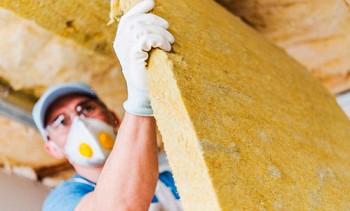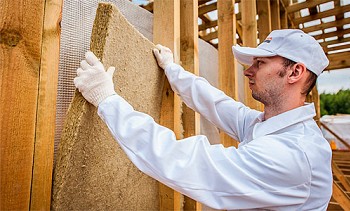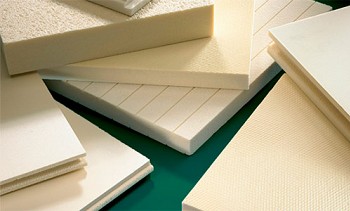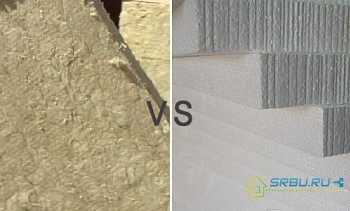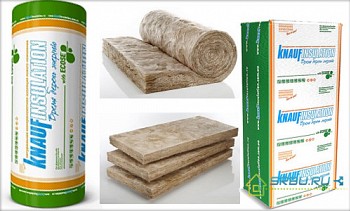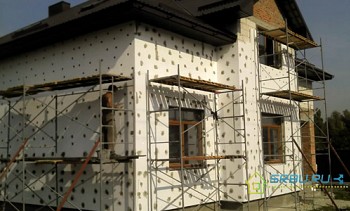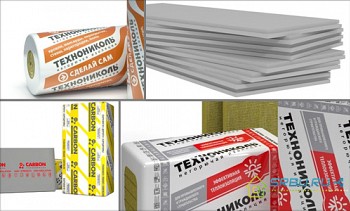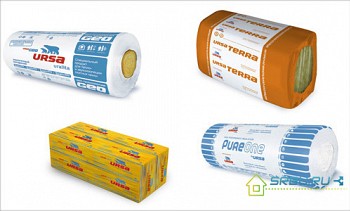Penoplex brand insulation is nothing more than extruded polystyrene foam. It belongs to a new formation of heat insulators, which are very effective in terms of heat conservation. In this article we will take a closer look at penoplex: technical specifications, pluses with minuses and areas of its application. To begin with, we note that this material is durable, almost does not absorb water and has a low coefficient of thermal conductivity.
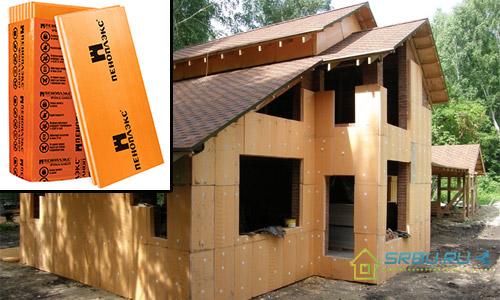
Content:
- The specifics of the production of Penoplex and its special properties
- For wall insulation of houses we use Penoplex Wall
- What is the difference between Penoplex Foundation material
- For a roof there is Penopleks Roofing
- Penoplex Comfort - for mansions, balconies and saunas
- Penoplex 45 - even withstand the weight of the aircraft
- Video: Properties and characteristics of Penoplex
The specifics of the production of Penoplex and its special properties
The first extrusion plant appeared in America more than half a century ago. In the manufacturing process, polystyrene granules are exposed to high pressure and temperature. The catalyst is a special foaming agent. This is usually a mixture of carbon dioxide and light freon. The resulting lush mass, resembling well-whipped cream, is squeezed out of the extrusion plant. After a while, freon disappears, and in its place air enters the cells.
Due to the extrusion of the manufactured material has a finely porous structure. Each of its identical tiny cells is isolated. The size of these cells is from 0.1 to 0.2 millimeters, they are evenly spaced inside the material. This makes the material strong and warm.
Absorption of water - minimum
For heat insulators, the ability to absorb moisture is an important characteristic. The following tests were carried out: Penoplex plates were left in the water for a month, immersed in it completely. Water was absorbed by them in small quantities only the first 10 days, after which the material ceased to take moisture. At the end of the term, the amount of water in the plates did not exceed 0.6 percent of their total volume. That is, moisture can penetrate only into the outer cells of the foam insulation, which were damaged when cutting the material. But inside the closed cells there is no access to water.
Thermal Conductivity - Small
Compared to many other heat insulators, the thermal conductivity of Penoplex is significantly lower. Its value is 0.03 W * m *0C. Since the material practically does not absorb water, it is quite possible to use it where there is a lot of humidity. At the same time, its thermal conductivity remains almost unchanged - it can fluctuate only from 0.001 to 0.003 W * m *0C. Therefore, roof tiles with attics and foundations with floors and basements can be insulated with Penoplex slabs, without additionally using a moisture protective layer.
Vapor permeability - low
Like any extruded polystyrene foam, Penoplex also has a high resistance to moisture evaporation. A layer of slabs of this material with a thickness of only 2 centimeters has the same vapor permeability as a layer of roofing material.
Service Life - Long
Many times, by freezing Penoplex plates, and then thawing them, the researchers found that all the characteristics of the material remain unchanged. According to the conclusion of the Institute of NIISF, these plates can serve as thermal insulation of houses for 50 years, no less. Moreover, this period is far from the limit, it is given with a large margin. At the same time, atmospheric effects are also taken into account.
When compressed - very resistant
As already mentioned, extrusion allows to achieve uniformity in the structure of the material.Uniformly distributed cells of a tiny size (tenths of a millimeter) improve the strength characteristics of the foam insulation. It does not change its size even under heavy loads.
Installation and handling - convenient and easy
This material is easily cut with the most ordinary knife. Penoplex slabs can quickly sheathe walls, without applying any special effort. When working with this insulation, do not be afraid that it will rain or snow. After all, Penoplex does not need protection from the weather.
Green - at a high level
Perhaps someone might be scared that freons are used in the manufacture of this material. But the fact is that freons of this type are absolutely safe - they do not burn, are not poisonous and do not destroy the ozone layer.
Reactivity is practically zero
Most chemicals used in construction are not able to react with Penoplex. There are, of course, exceptions - some organic solvents can soften insulation boards, disrupt their shape or even completely dissolve.
Such substances include the following:
- Toluene, xylene, benzene and the like hydrocarbons (aromatic);
- formalin and formaldehyde;
- substances from the class of ketones - methyl ethyl ketone, acetone;
- ethers, both simple and complex - methyl acetate and ethyl acetate solvents, diethyl ether;
- gasoline, kerosene and diesel fuel;
- polyesters used as an epoxy hardener;
- coal tar;
- oil-based paints.
Here is a list of substances that are not able to damage Penoplex:
- Any kind of acid - organic and inorganic;
- salts in the form of solutions;
- alkalis;
- alcohols and paints based on them;
- water and water paints;
- bleach (bleaching) lime;
- oxygen, carbon dioxide;
- butane, propane, ammonia;
- oils (both animal and vegetable), paraffins;
- cement and concrete mortars;
- freons.
It is also worth noting that the biostability of the plates of this insulation is also high - they do not rot and do not decompose.
However, for the invariability of the shape and size of the Penoplex boards, it is necessary to withstand the permissible ambient temperature at which this insulation can be operated. Usually this parameter is indicated in the material passport. With excessive heating, not only the size, but also the characteristics of the Penoplex can change, because it can not only melt but also ignite. However, this is a drawback of all foams, as you can see by watching the following video:
Video: How Penoizol, Styrofoam and Penoplex burn
For insulation of walls of houses use Penopleks Wall

This name is newer - earlier this heat insulator was called PENOPLEX 31 with flame retardants. However, the essence of this has not changed. Plinths, facades, partitions, internal and external walls of buildings with this material to insulate very well.
Moreover, the walls are insulated on the inside only if, for some reason, this cannot be done from the outside. Or for urgent repairs it is also convenient to sheathe the walls with insulation from the inside. PENOPLEX STENA® is excellent for these purposes - it is very simple to mount.
As for external use, this material showed itself very well with well laying of walls. Compared to traditional brick, such walls are much thinner (several times), but they are not inferior to them in terms of reliability or ability to retain heat.
Insulation Penopleks Wall can be used to create plastered facades. Since decorative plaster, sold everywhere, shines with a variety of types and colors, the house will turn out to be original and unique.
| Options | Units measuring | Values |
|---|---|---|
| Heat conductivity coefficient at (25 ± 5) ° С | W / (m × ° K) | 0,03 |
| Density | kg / m³ | 25,0-32,0 |
| Compressive strength at 10% linear strain, not less | MPa (kgf / cm2; t / m2) | 0,20 |
| Water absorption in 28 days | % by volume | 0,5 |
| Fire Resistance Category | Group | G3 |
| Operating temperature range | ° C | -50 ... +75 |
What is the difference between Penoplex Foundation material

As the name implies, this insulation (previously called PENOPLEX 35 without flame retardant) is good for foundations. Its plates are durable and able to withstand significant loads. PENOPLEX FOUNDATION is also suitable for garden paths, socles, floors - where high fire resistance is not needed. Structures with a small load, having a protective layer (for example, a sand-cement screed) can also be insulated with them.
The slabs of this heat insulator contribute to the quick solution of all problems associated with the construction of the base of the house, as well as the equipment of the basement. Reliable protection of waterproofing, ensuring the removal of groundwater are the advantages of this material. PENOPLEX FOUNDATION allows you to reduce the pressure of these waters on the underground part of the house and its basement.
| Options | Units measuring | Values |
|---|---|---|
| Heat conductivity coefficient at (25 ± 5) ° С | W / (m × ° K) | 0,03 |
| Density | kg / m³ | 29,0-33,0 |
| Compressive strength at 10% linear strain, not less | MPa (kgf / cm2; t / m2) | 0,27 (2,7; 27) |
| Water absorption in 28 days | % by volume | 0,5 |
| Fire Resistance Category | Group | G4 |
| Operating temperature range | ° C | -50 ... +75 |
| Standard sizes, width / length / thickness | mm | 600/1200/20; 30; 40; 50; 60; 80; 100 |
For a roof there is Penopleks Roofing

This insulation used to be called PENOPLEX 35. They can insulate any type of roof. Today in construction, a lightweight type roof is often used. It is important to make it strong enough, reliable, easy to use and long lasting. The same task is faced when repairing a roof of a flat shape, the basis of which are profiled metal sheets. For such cases, the company "PENOPLEX" has a fire-resistant material from the series "PROOF".
Often this insulation is used for warming flat roofs, as well as for warming the attic of a ventilated roof.
Inverse type roofs are now very popular. Indeed, in modern cities there is not so much free space, and such a roof can successfully use the roof for different purposes. For example, make a green island on it, planting trees and flowers. Or place a parking lot. PENOPLEX® is quite capable of withstanding heavy loads, so it is used for these needs.
| Options | Units measuring | Values |
|---|---|---|
| Heat conductivity coefficient at (25 ± 5) ° С | W / (m × ° K) | 0,03 |
| Density | kg / m³ | 28,0-33,0 |
| Compressive strength at 10% linear strain, not less | MPa (kgf / cm2; t / m2) | 0,25 (2,5; 25) |
| Water absorption in 28 days | % by volume | 0,5 |
| Fire Resistance Category | Group | G3 |
| Operating temperature range | ° C | -50 ... +75 |
| Standard sizes, width / length / thickness | mm | 600/1200/20; 30; 40; 50; 60; 80; 100 |
Penoplex Comfort - for mansions, balconies and saunas

This material (previously called PENOPLEX 31C) is universal. If you want - insulate them with a country cottage or cottage, if you want - a loggia or balcony. For insulation of a private house, this insulation is just perfect. They can cover the floor, foundation, basement, roof and walls. If you have a swimming pool, sauna or bathhouse, then PENOPLEX®KOMFORT is also suitable for thermal insulation of their walls, as it can withstand high humidity. It is a kind of universal insulation of this brand.
| Options | Units measuring | Values |
|---|---|---|
| Heat conductivity coefficient at (25 ± 5) ° С | W / (m × ° K) | 0,03 |
| Density | kg / m³ | 25,0-35,0 |
| Compressive strength at 10% linear strain, not less | MPa (kgf / cm2; t / m2) | 0,20 (2,0; 20) |
| Water absorption in 28 days | % by volume | 0,5 |
| Fire Resistance Category | Group | G4 |
| Operating temperature range | ° C | -50 ... +75 |
| Standard sizes, width / length / thickness | mm | 600/1200/20; 30; 40; 50; 60; 80; 100 |
Penoplex 45 - even withstand the weight of the aircraft

This material can not only insulate roofs of the inverse type. It is used for thermal insulation of highways, railroad tracks and even on airfield runways. The strongest plates of this brand of foam plastic do not change their properties throughout the entire service life. And they have a very long one.
Why warm roads and railways? The fact is that this protects them from a very unpleasant phenomenon - bloating as a result of freezing. There are types of soil that absorb water very actively. All spring, summer and autumn, they accumulate it inside.If the road is built on such soil, then in winter it may crack due to its expansion. If it is insulated, then the soil either will not freeze at all, or it will freeze much less.
| Options | Units measuring | Values |
|---|---|---|
| Heat conductivity coefficient at (25 ± 5) ° С | W / (m × ° K) | 0,03 |
| Density | kg / m³ | 35,0-47,0 |
| Compressive strength at 10% linear strain, not less | MPa (kgf / cm2; t / m2) | 0,50 (5; 50) |
| Water absorption in 28 days | % by volume | 0,4 |
| Fire Resistance Category | Group | G4 |
| Operating temperature range | ° C | -50 ... +75 |
| Standard sizes, width / length / thickness | mm | 600/1200/40; 50; 60; 80; 100 |

